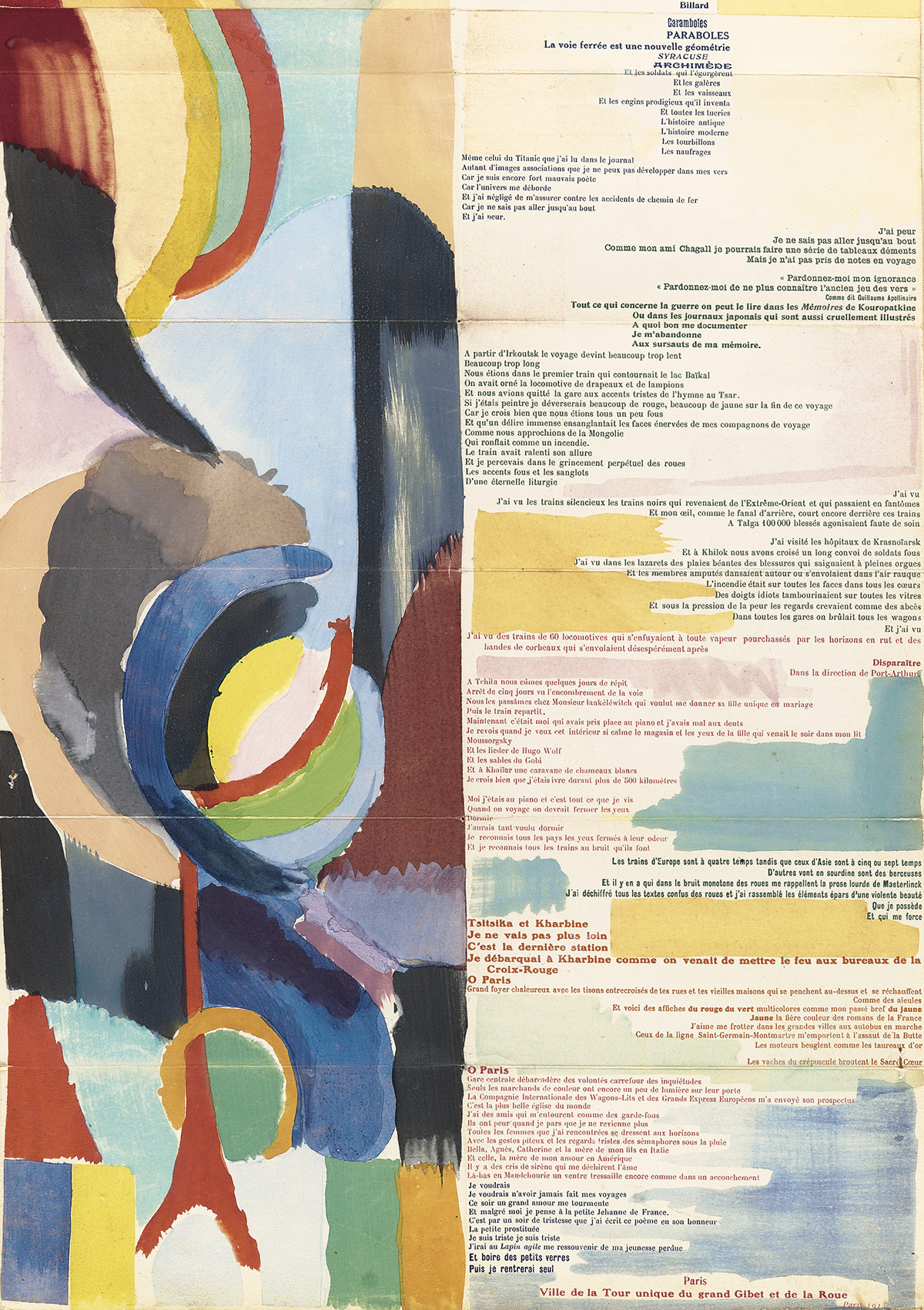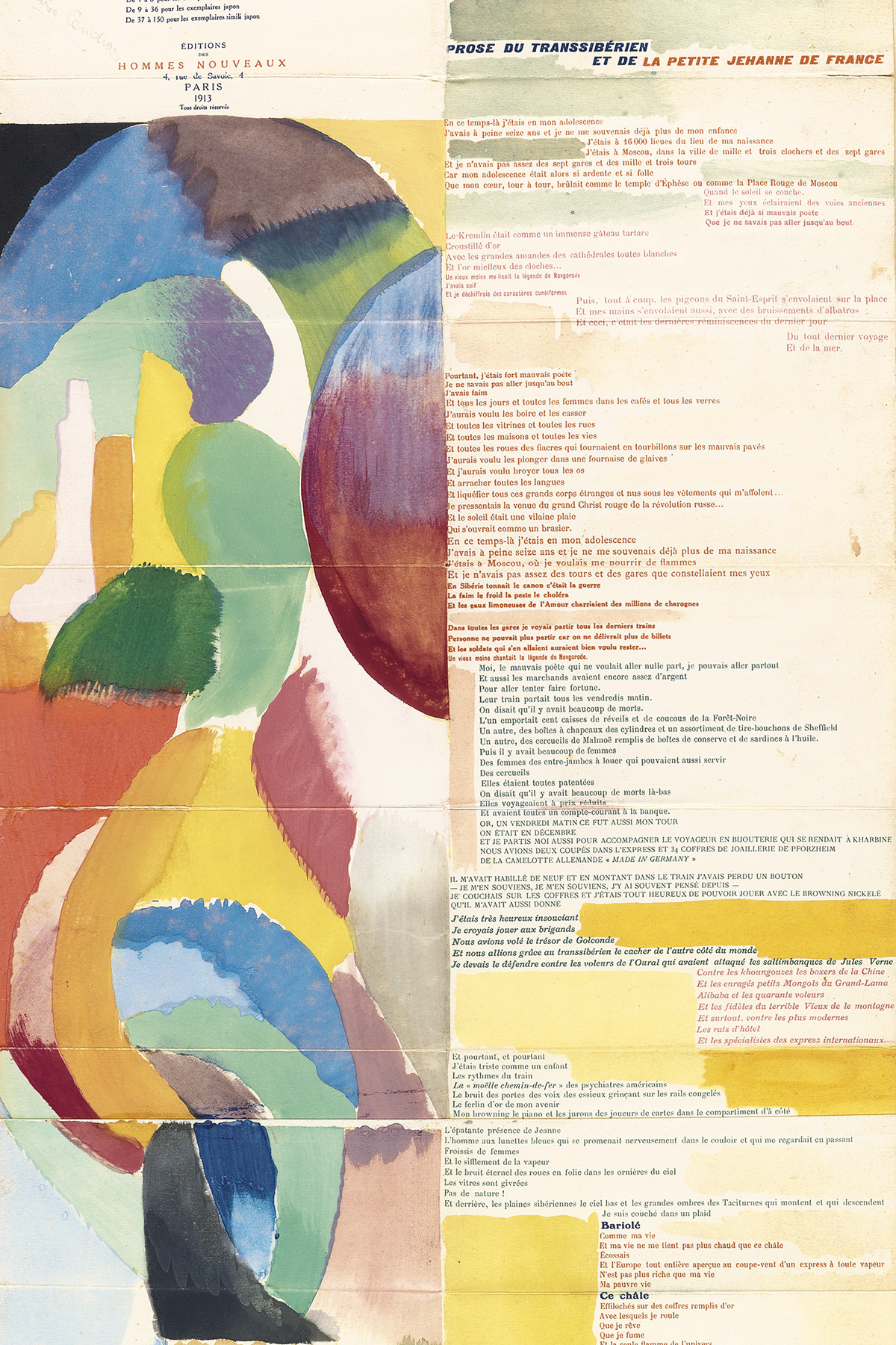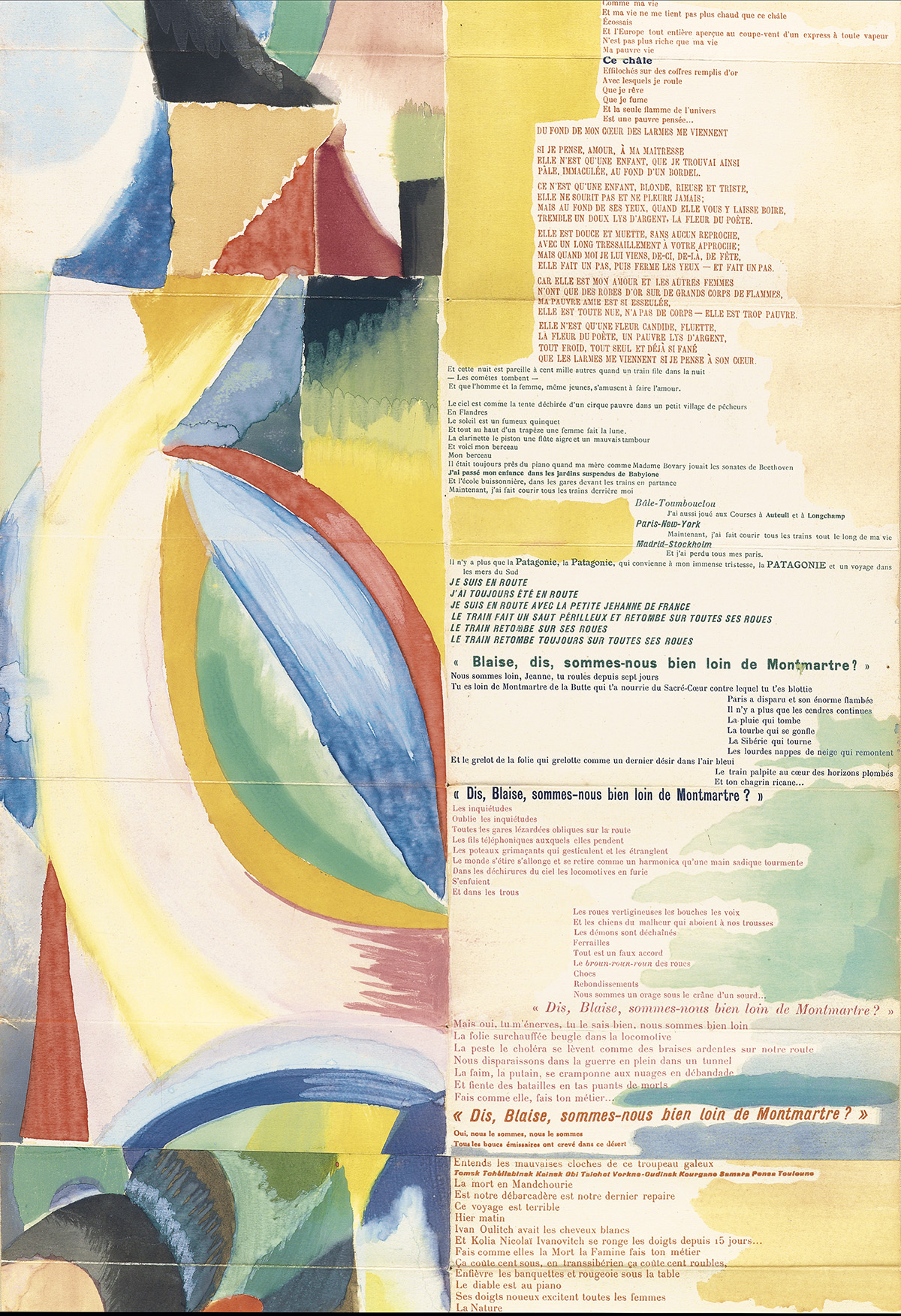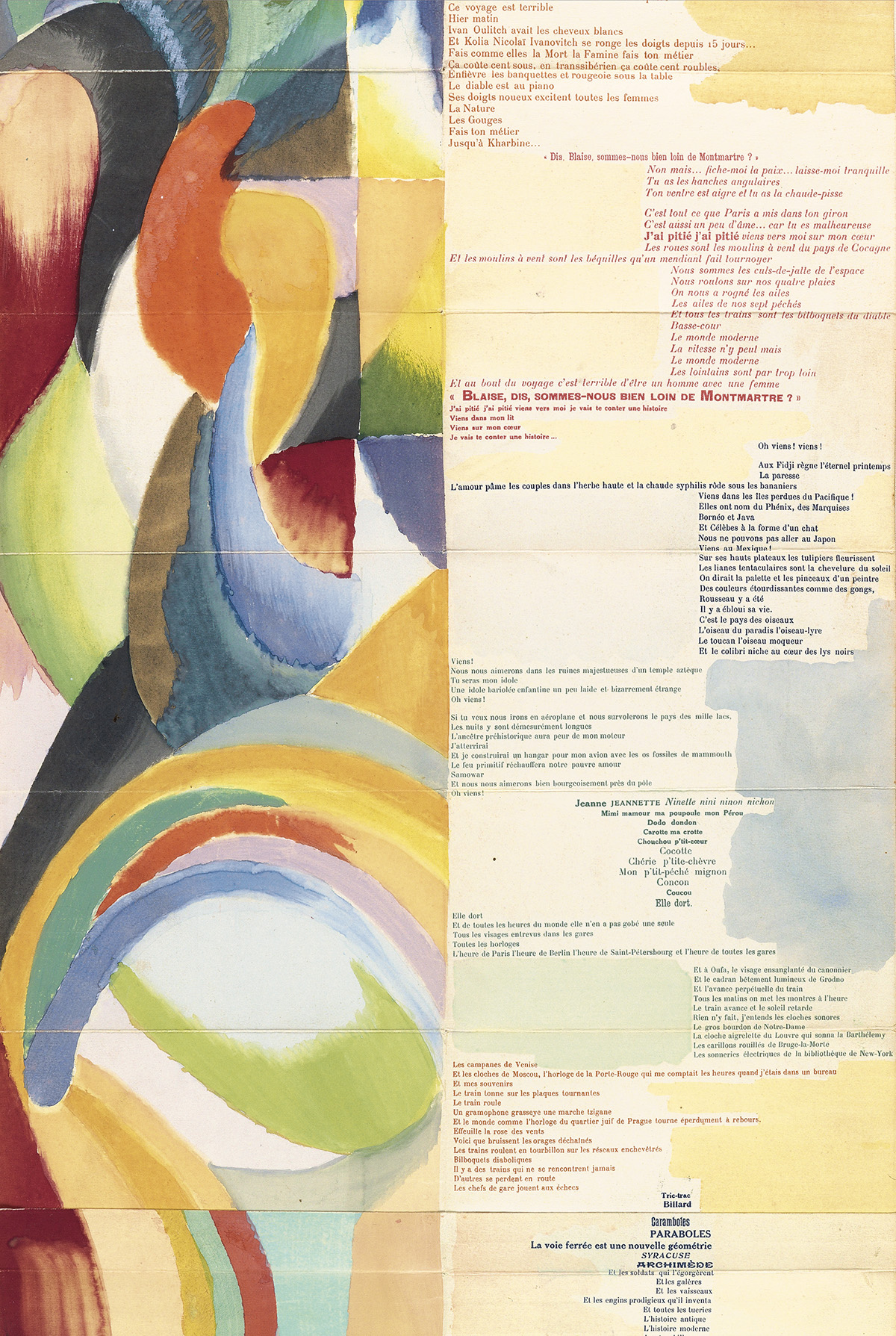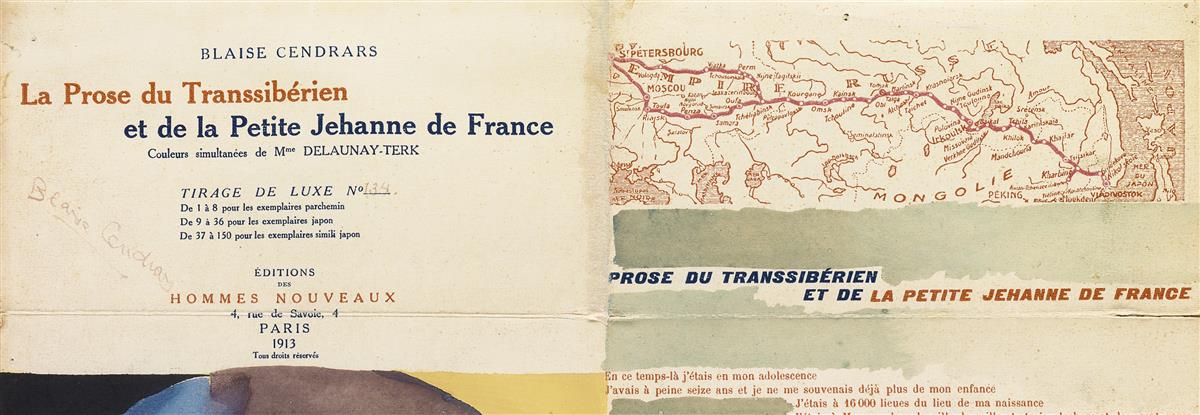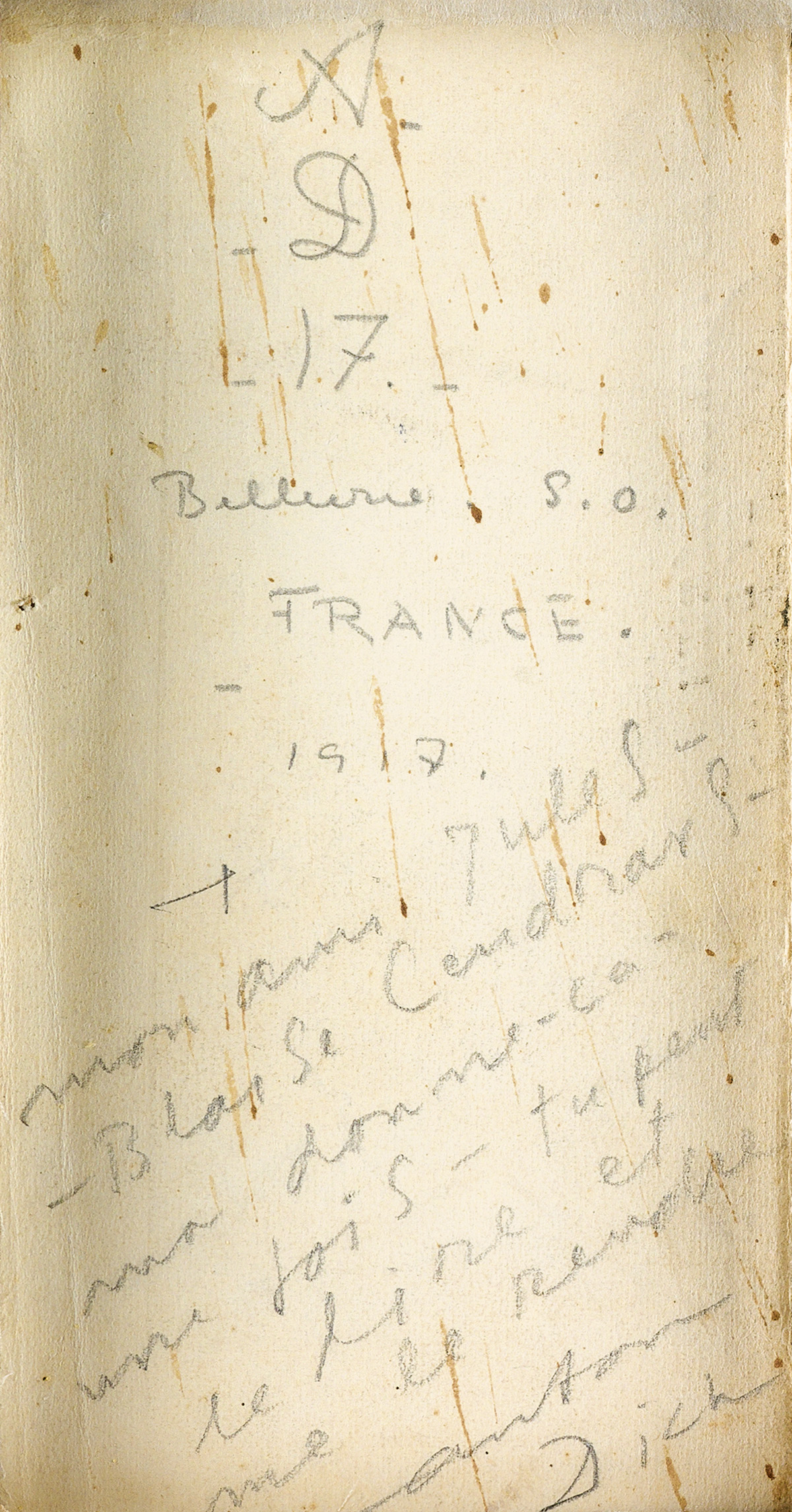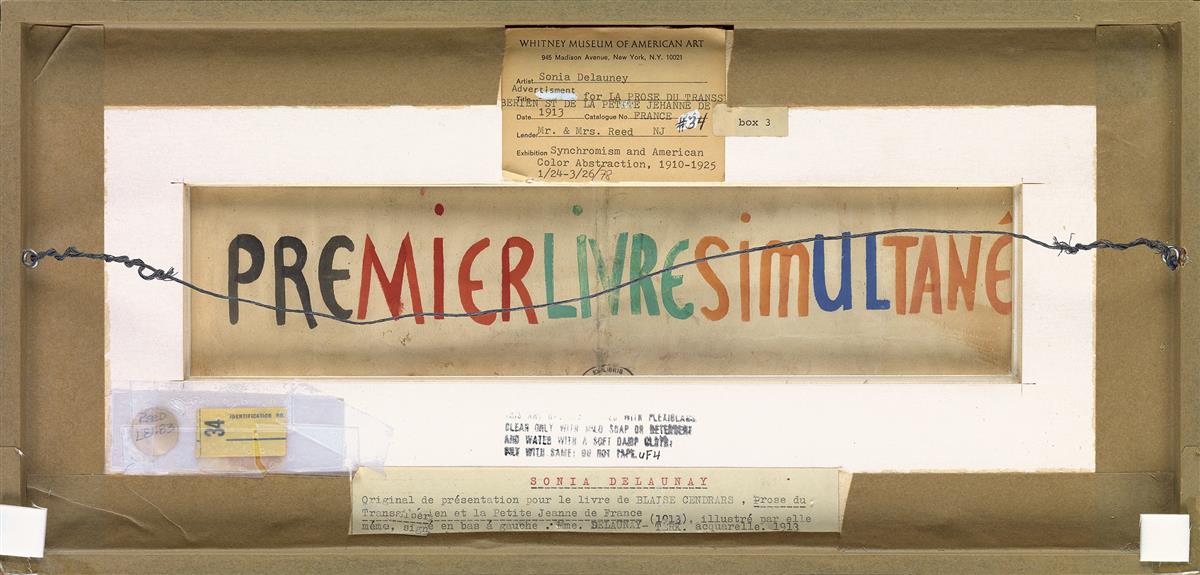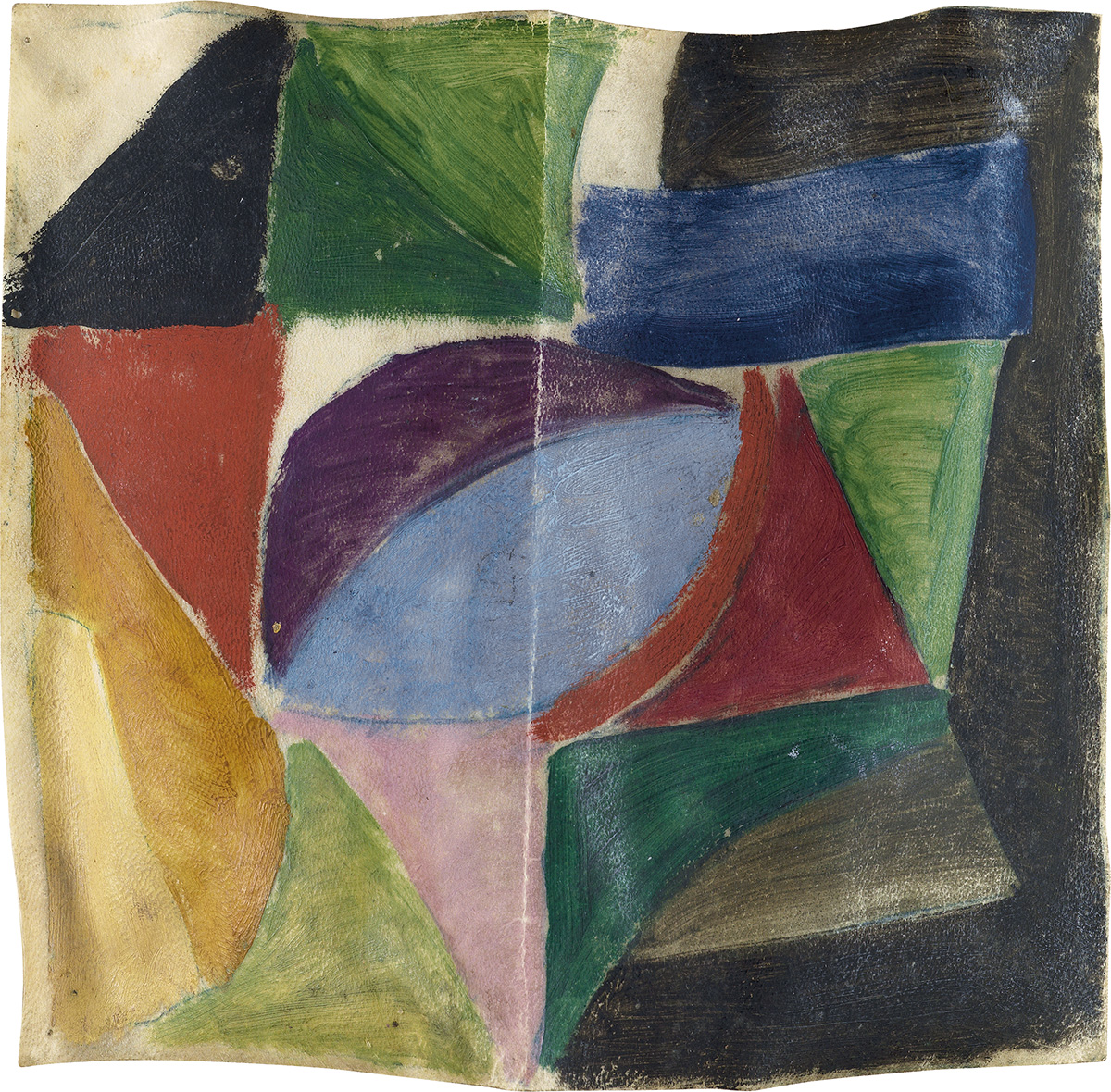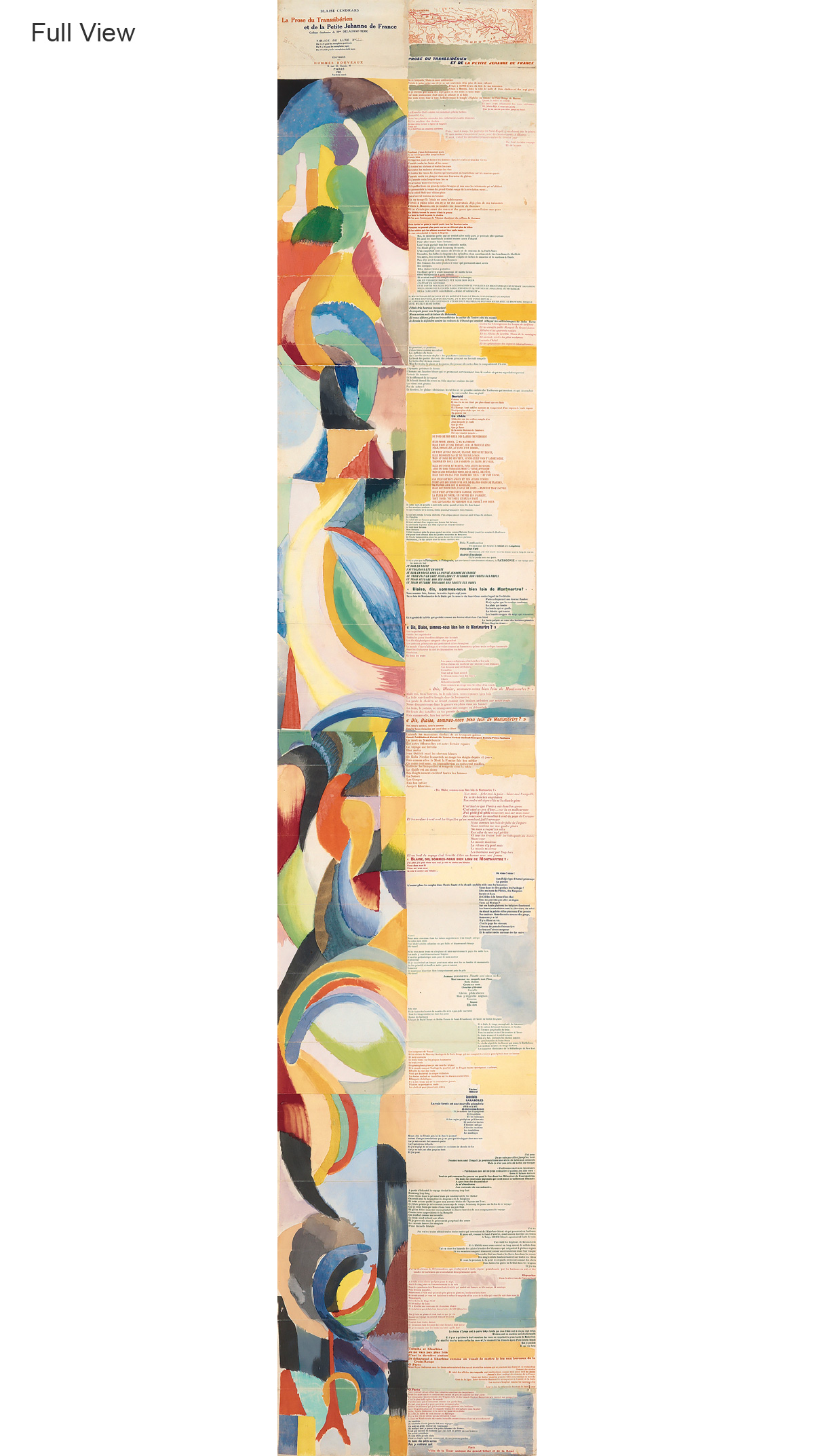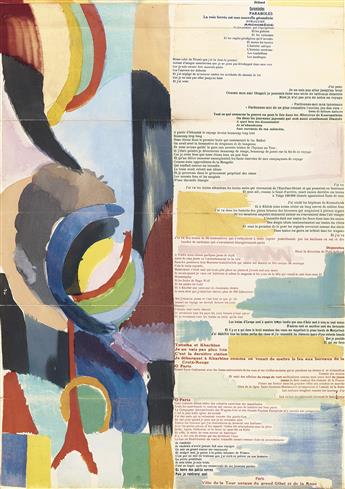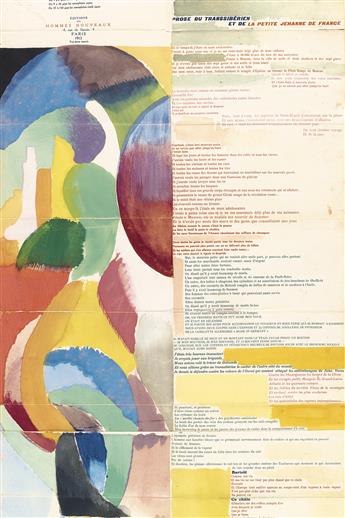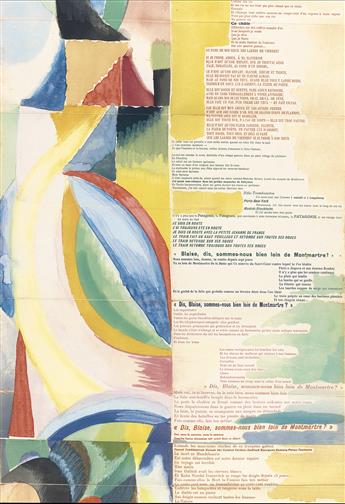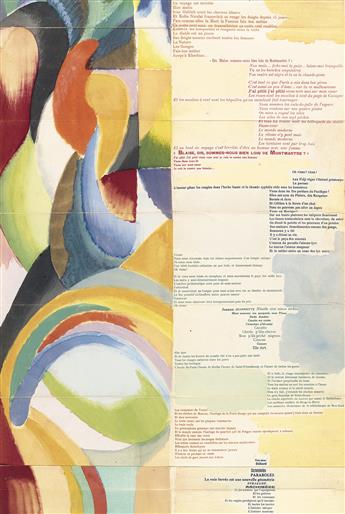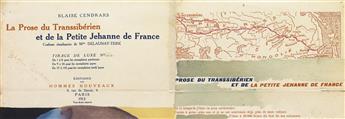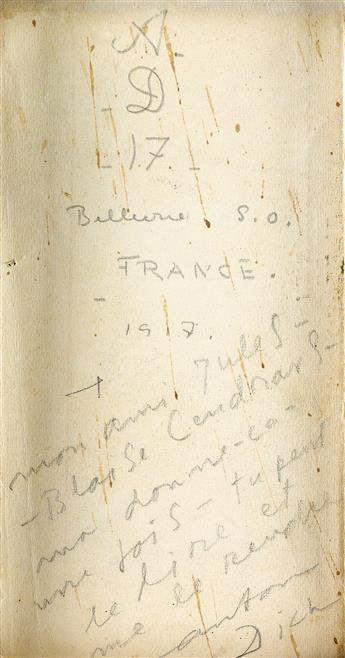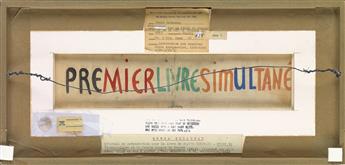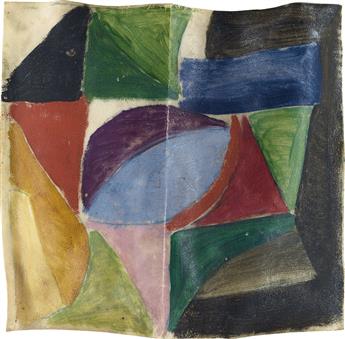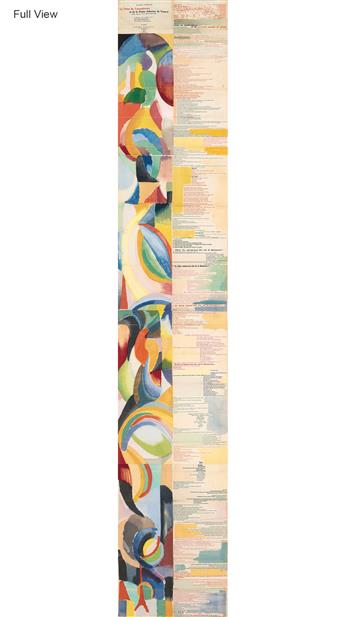Sale 2500 - Lot 393
Price Realized: $ 70,000
Price Realized: $ 87,500
?Final Price Realized includes Buyer’s Premium added to Hammer Price
Estimate: $ 70,000 - $ 100,000
SONIA DELAUNAY
La Prose du Transsibérien et de la petite Jehanne de France by Blaise Cendrars.
Color pochoir with hand-applied watercolor on 4-joined sheets of imitation Japan paper, accordion-folded as issued, 1913 (now unfolded and framed). 1980x350 mm; 78x14 inches. Complete with original parchment wrapper, oil on vellum, 180x180 mm; 6 1/2x7 1/27x7 inches and original announcement, watercolor on cream wove paper, 330x90 mm; 13 1/4x3 1/2 inches. Edition of approximately 60-100, from an intended edition of 150. Signed by Cendrars and numbered "134" in violet ink, upper left; initialed by the artist and annotated in pencil, verso. Published by Éditions des Hommes Nouveaux, Paris.
With a signed letter of authenticity from the artist, Paris, June 5, 1971.
The original watercolor announcement exhibited Whitney Museum of American Art, New York, "Synchronism and American Color Abstraction, 1910-1925," January 24, 1978-April 26, 1978, with the label on the frame back.
Created by artist Delaunay (1885-1979) and poet Blaise Cendrars (née Frédéric-Louis Sauser, 1887-1961), the intention of this work was to explore the frustrating yet wondrous experience of living through a period of ever-accelerating modernity. Cendrars' poem is a semi-autobiographical account of a journey through Russia on the Trans-Siberian Express in 1905, during the Russian Revolution. Abrupt shifts in time and space throughout the poem highlight the unfamiliar, surreal experience of travelling with new technologies in a foreign environment. Structurally, the work itself is a testament to the power of modernity in the early 1900s; if each impression from the full intended edition of 150 were laid end-to-end, they would equal the height of the Eiffel Tower, which had been completed just 24 years previously. The Eiffel Tower was such an impactful theme that the only clearly figurative aspect of Delaunay's pochoir is the depiction of the Tower, at the lowermost panels. The poem itself has a stacatto rhythm echoing the sound of a train on tracks, and the ebb and flow of the text is echoed in the movement of Delaunay's pochoir; the colors blur and take form as though they are a landscape looked at through a window and abstracted by the speed of a train.
With her illustration of the poem, Delaunay's design is a key example of "simultaneisme" (simultanism), a theory she developed along with her husband, Robert Delaunay (1885-1941), which postulated that a lyrical and harmonious effect could be produced by arranging certain colors and forms together. With the use of dynamic, organic shapes and contrasting colors, Delaunay created the corresponding visual narrative to Cendrars' poem. She created the piece not by reading the poem, but by listening to Cendrars recite it, thereby emphasizing the symphonic quality of the piece.
The strength of the lyrical composition that Delaunay and Cendrars produced caused a sensation in the avant-garde community, and it is widely considered one of the first and among the most important artist's books of the 20th century.
La Prose du Transsibérien et de la petite Jehanne de France by Blaise Cendrars.
Color pochoir with hand-applied watercolor on 4-joined sheets of imitation Japan paper, accordion-folded as issued, 1913 (now unfolded and framed). 1980x350 mm; 78x14 inches. Complete with original parchment wrapper, oil on vellum, 180x180 mm; 6 1/2x7 1/27x7 inches and original announcement, watercolor on cream wove paper, 330x90 mm; 13 1/4x3 1/2 inches. Edition of approximately 60-100, from an intended edition of 150. Signed by Cendrars and numbered "134" in violet ink, upper left; initialed by the artist and annotated in pencil, verso. Published by Éditions des Hommes Nouveaux, Paris.
With a signed letter of authenticity from the artist, Paris, June 5, 1971.
The original watercolor announcement exhibited Whitney Museum of American Art, New York, "Synchronism and American Color Abstraction, 1910-1925," January 24, 1978-April 26, 1978, with the label on the frame back.
Created by artist Delaunay (1885-1979) and poet Blaise Cendrars (née Frédéric-Louis Sauser, 1887-1961), the intention of this work was to explore the frustrating yet wondrous experience of living through a period of ever-accelerating modernity. Cendrars' poem is a semi-autobiographical account of a journey through Russia on the Trans-Siberian Express in 1905, during the Russian Revolution. Abrupt shifts in time and space throughout the poem highlight the unfamiliar, surreal experience of travelling with new technologies in a foreign environment. Structurally, the work itself is a testament to the power of modernity in the early 1900s; if each impression from the full intended edition of 150 were laid end-to-end, they would equal the height of the Eiffel Tower, which had been completed just 24 years previously. The Eiffel Tower was such an impactful theme that the only clearly figurative aspect of Delaunay's pochoir is the depiction of the Tower, at the lowermost panels. The poem itself has a stacatto rhythm echoing the sound of a train on tracks, and the ebb and flow of the text is echoed in the movement of Delaunay's pochoir; the colors blur and take form as though they are a landscape looked at through a window and abstracted by the speed of a train.
With her illustration of the poem, Delaunay's design is a key example of "simultaneisme" (simultanism), a theory she developed along with her husband, Robert Delaunay (1885-1941), which postulated that a lyrical and harmonious effect could be produced by arranging certain colors and forms together. With the use of dynamic, organic shapes and contrasting colors, Delaunay created the corresponding visual narrative to Cendrars' poem. She created the piece not by reading the poem, but by listening to Cendrars recite it, thereby emphasizing the symphonic quality of the piece.
The strength of the lyrical composition that Delaunay and Cendrars produced caused a sensation in the avant-garde community, and it is widely considered one of the first and among the most important artist's books of the 20th century.
Exhibition Hours
Exhibition Hours
Aliquam vulputate ornare congue. Vestibulum maximus, libero in placerat faucibus, risus nisl molestie massa, ut maximus metus lectus vel lorem.



